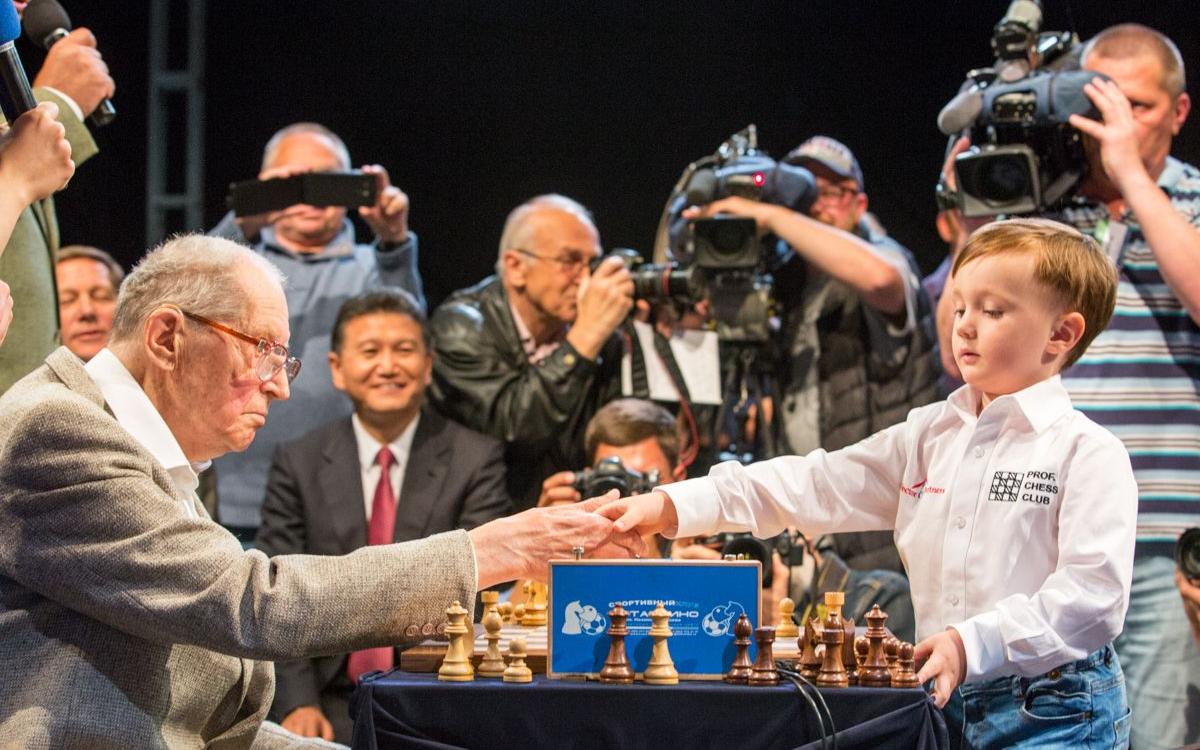
The Youngest Chess Stars
The news about the four-year old Misha Osipov beating a grandmaster spread the world like wildfire. It must be a new record by a wide margin. Many people think that little Misha is going to be the world champion one day for sure.
Photo: Chess.com/Maria Emelianova.
So, are we lucky to witness the development of the biggest chess genius in the history of chess?
I wouldn't rush with that conclusion since I know way too many stories about young chess players who were "destined for greatness." One of the most recent examples is the story of Nicholas Nip. In March of 2008 the USCF website ran a story about the youngest master ever. Nicholas managed to obtain the coveted title when he was just nine years and 11 months, breaking Hikaru Nakamura's record that stood for a decade!
The instant fame propelled Nicholas to one of the most popular TV shows at the time, "Regis and Kelly"
The U.S. chess community got very excited. Indeed, the logic was very simple: if the kid broke Hikaru's record, then we must have Nakamura 2.0 in the making! Just read some of the comments for the article that broke the news: "The future of chess lies with this young man," "Searching for Nicholas Nip," etc.
By the way, the last comment refers to the blockbuster movie "Searching for Bobby Fischer." Ironically, there is indeed something common between the great world champion and Nicholas Nip. Both of them retired from chess at the moment of their biggest triumph. Yes, you read it right, the 10-year old kid retired from chess and according to the USCF website hasn't played a single rated game since 2008!
To get you an idea about Nicholas' strength, here is one of the last games he ever played:
One of the most hyped chess prodigies of all times was Ernest Kim. In the end of 1950s his name was everywhere. He was shown in a Soviet documentary (start from 0:30).
His picture graced the cover of the most influential chess magazine of that time:

The caption reads: "The Tashkent Pioneer Palace. The third category player 6 year-old Ernest Kim is playing a second category player Khurshid Muratov. Their coach G. Shakh-Zade is watching."
Ernest Kim was also a star in a book published in 1961 by Tashkent master Birbrager. Here is a picture from the chapter "Five-year-old champions"

The caption reads: "It is not easy to play vs. young Ernest!"
It is difficult to distinguish the hype from the truth. The games you can find in databases add more confusion. Judge for yourself:
It says that the game was played in 1953, the year Ernest Kim was born! Also the way Black played, making a draw from the position of strength vs. a legendary Soviet grandmaster can really puzzle you. It definetely doesn't look like a third category player, since at that point a third category would be roughly the same as USCF 1500 today.
This and many other inconsistencies made many people wonder if Ernest Kim even existed, or if he was a product of the Soviet propaganda. Let me reassure you that there was indeed a very talented boy Ernest Kim. While I never saw Ernest in person, 20 years after him I attended the same Tashkent Pioneer Palace pictured on the cover of the "Chess In The Soviet Union" magazine. I knew many people who coached or participated in the same events as Ernest Kim. I was scolded on some occasions by a very stern master Mamadzhon Mukhitdinov, who at the time wrote a very brief article begging to stop the hype around Ernest Kim. In that article he warned that the fame would spoil the talented boy. Unfortunately, it looks like that's exactly what happened since it is not clear why Ernest Kim disappeared from the chess world and where he is now.
By the way, it is funny to trace the future of three boys from the above-mentioned book by Birbrager. The biggest hype was understandably given to Ernest Kim, but then the author was describing the bright future of another prodigy Gregory Barenboym. At the end Birbrager mentions a talented five-year-old boy from the Uzbek city of Almalyk, who already knows chess notation. It is not such a big surprise if you consider that he has been playing chess since he was only three years old. The boy's name is Georgy Agzamov.
You can notice that the kids' chess achievements were inversely proportional to the hype. Ernest Kim simply disappeared from the chess world, while Gregory Barenboym became a strong candidate master (at that point around USCF 2200). I was very proud when as a teenager I managed to beat him! But of course it was Georgy Agzamov who achieved the most in chess! Not only did he become the first grandmaster of the Central Asia, but he also won numerous international tournaments and was well known for his very specific style of play.
His nickname "клещ" (in Russian: mite) was similar in meaning to GM Adams' nickname "spider." Unfortunately Georgy Agzamov's chess career was interrupted by his tragic death.
Let's return to Misha Osipov.

Photo: Chess.com/Maria Emelianova.
One record he set for sure is the amount of hype around him. Thanks to the modern mass media plus the Internet, he left Ernest Kim way behind. If his parents and coaches can shield the little boy against excessive publicity, then he indeed can become a big chess player. Otherwise, he will be another young chess star that burned completely.






